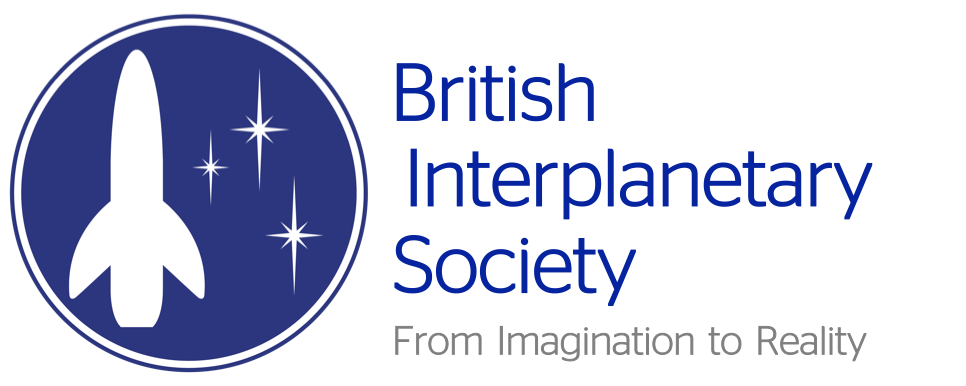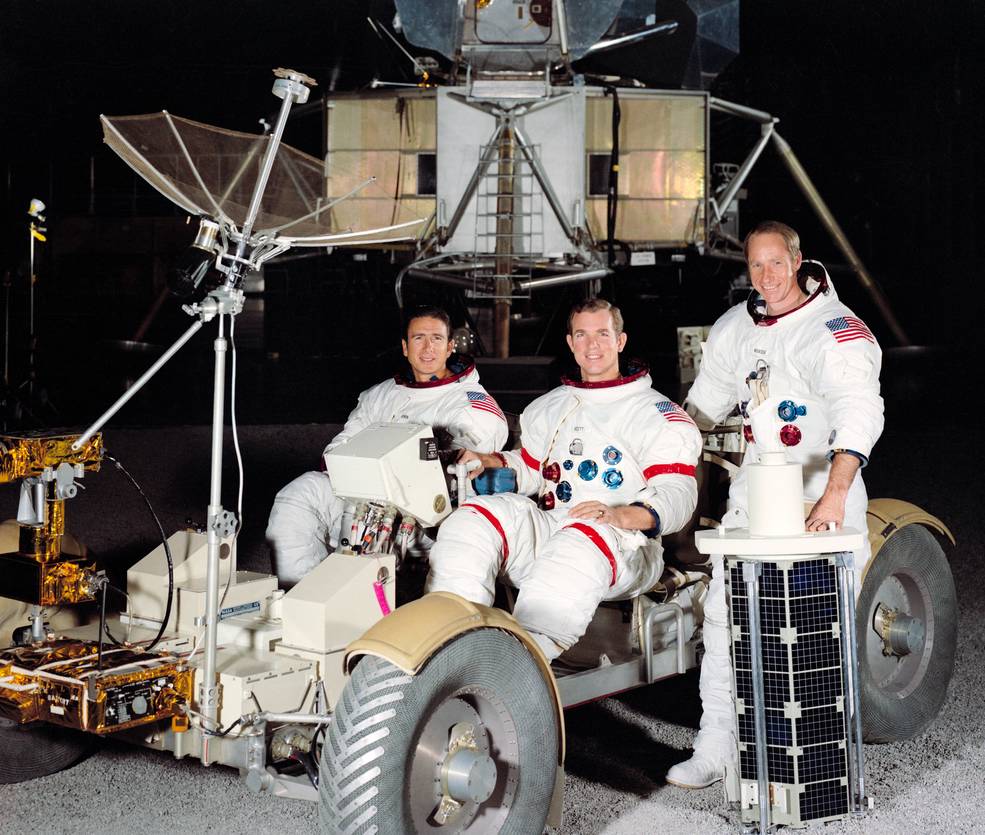An evening celebrating Apollo 15, the first scientific expedition to the Moon.
This special evening will take place via Crowdcast, and we will be joined by speakers from the USA, UK and Europe. More information on the individual talks can be found below – please keep checking back as further information will be published nearer the time.
Please note that all timings shown are British Summer Time (GMT+1). Tickets cost £5 and can be bought directly on the Crowdcast system.
1700 Welcome to Part 1
1710 Jerry Stone: Driving To Explore: Looking back on Apollo 15 with live Q&A
1840 Continuation on Part 2
1845 Fabrizio Bernardini: Apollo 15 Technicalities – with live Q&A
2030 Thank you and conclusion
___________________
“Driving To Explore: Looking back on Apollo 15” (Jerry Stone)
In his series of presentations marking the 50th anniversary of each of the Apollo flights, Jerry Stone has now reached Apollo 15.
This was the first of the “J” missions, with an enhanced focus on the science of the Moon. Exploring a really dramatic landing site, with mountains and the winding canyon of Hadley Rille, the astronauts were greatly assisted by having the first “Moon car”, which allowed them to carry more equipment and to cover far greater distances than had been possible on previous missions. The additional science extended to the work carried out from orbit, including panoramic mapping of the lunar surface. As usual, Jerry will be adding some special touches, including artwork on the Moon and details of special customisation of the lunar rover. He will also bring along newspapers reporting the mission and telling what else was happening half a century ago.
Jerry Stone is a Freelance Space Presenter, and runs Spaceflight UK. He has given presentations on astronomy and space exploration since 1969 all across the UK and abroad. He is a Fellow of the BIS and is highly regarded as a space expert, particularly on the Apollo program. He has often been interviewed on TV and radio, has written two space books and been the consultant on various others. He also presents space workshops for schools all over the UK, and also as team-building exercises for companies.
___________________
Apollo daughters: astronauts and engineers (Alison Penczak & Helen Peoples, hosted by Vix Southgate)
Vix Southgate, former European Manager and close friend of Apollo 15 CMP, Al Worden is in conversation with Apollo daughters; Al’s daughter Alison Penczak and John Healey’s daughter Helen Peoples, in which they discuss what it was like growing up as part of the Apollo programme, their experiences, and memories of their Fathers and their role in Apollo.
Alison Worden Penczak is the daughter of Apollo 15 Command Module Pilot Col. Al Worden. Born in an army hospital in Washington DC, Alison spent her early years doing a tour of duty at Farnborough, growing up at Edwards Air Force base, and living alongside other astronaut families a few miles from NASA in Houston; the space program has been part of her entire life. Alison now manages her Father’s estate and is associated with the Al Worden Endeavour Scholarship Foundation, which was founded and launched by Al in 2019. This educational programme raises money for students around the world to attend Space Camp in Huntsville, AL. She is married and the proud mother of two sons and currently resides on the Olympic Peninsula of Washington State.
Helen Peoples is daughter of John P. Healey (1922 – 2019). On January 27, 1967 U.S. astronauts Gus Grissom, Ed White, and Roger Chaffee were killed when fire broke out in their Apollo spacecraft during a launch pad test. This changed Helen’s life forever, as her father was brought in as the spacecraft manager by North American Rockwell – he is now best known for his role in the redesign and manufacture of the command modules for the Apollo program. She went from riding horses atop vast mesas in Colorado to learning how to safely swim in the ocean and learning how to drive the Los Angeles freeway system when her family had to relocate to South California so he could take up this position. She attended St. Joseph Catholic Girls High School in Lakewood, California, which she describes as the most grounding and influential four years of my life. She met and married her high school sweetheart, Jim Peoples. They got married, he joined the Air Force and they so began the next 40 years together – before his sudden death in 2014 in a plane crash. Helen has two daughters and one granddaughter. She serves on the Board for Jefferson Center for Mental Health. She enjoys hiking the trails near her home, playing the piano, reading historical novels and traveling. Helen has three dogs (two of which are rescues), wonderful friendships and great memories of having been part of one of the most important historical times — thanks to her father, John Patrick Healey.
___________________
Apollo 15 Technicalities (Fabrizio Bernardini)
A short overview of some technical aspects that made A15 different from the previous Apollo Moon landing missions, precursors to the J-series missions that opened the Moon to science exploration.
Fabrizio Bernardini, FBIS, is an engineer who works as a consultant in the aerospace sector with different roles, and also manages the operations of a radar instrument orbiting Mars. As a “child of Apollo” he has been always interested in space technology, astronautics and in particular avionics and operations, and he likes to mix work and outreach as well as education. As a long-standing BIS member, he manages the Italian branch of the BIS and enjoys working with a local team of other space enthusiasts on the next event or next project that will help take the public from imagination to reality.
___________________
“Apollo 15, the First Scientific Expedition to the Moon: How Science and Engineering Synergism Led from Apollo 11 to Apollo 15 and Beyond” (Professor Jim Head)
The Apollo Lunar Exploration Program accomplished six successful lunar landings. Each succeeding Apollo mission was characterized by increasing exploration capabilities (landing accuracy, stay time, EVAs, mobility, experiments, tools, etc.). We present a brief review of the landing sites, surface operations and science return of each succeeding Apollo mission and show how science and engineering synergism resulted in a rapid transition from achieving a national goal (Apollo 11) to sophisticated scientific expeditions targeted to areas critical to understanding the origin and evolution of the Moon. We focus on Apollo 15, The First Scientific Expedition to the Moon, to illustrate the fundamental scientific excitement and return from this mission and its exciting legacy. We suggest some potential insights for the Artemis Program to the Moon and Forward to Mars.
Professor Jim Head is the Louis and Elizabeth Scherck Distinguished Professor of Geological Sciences. He came to Brown University in 1973, following his work with the NASA Apollo program, in which he analyzed potential landing sites, studied returned lunar samples and data, and provided training for the Apollo astronauts. His current research centers on the study of the processes that form and modify the surfaces, crusts and lithospheres of planets, how these processes vary with time, and how such processes interact to produce the historical record preserved on the planets. Comparative planetology, the themes of planetary evolution, and application of these to the study of early Earth history are also of interest. He has followed up his research on volcanism, tectonism and glaciation with field studies on active volcanoes in Hawaii and at Mount St. Helens, on volcanic deposits on the seafloor with three deep sea submersible dives, and during five field seasons in the Antarctic Dry Valleys.
Since 1984, Dr. Head convenes the Vernadsky Institute/Brown University microsymposia, held twice yearly in Moscow and Houston. He has served as an investigator with NASA and Russian Space Missions, such as the Soviet Venera 15/16 and Phobos missions, and the US Magellan (Venus), Galileo (Jupiter), Mars Surveyor, Russian Mars 1996, and Space Shuttle missions.





